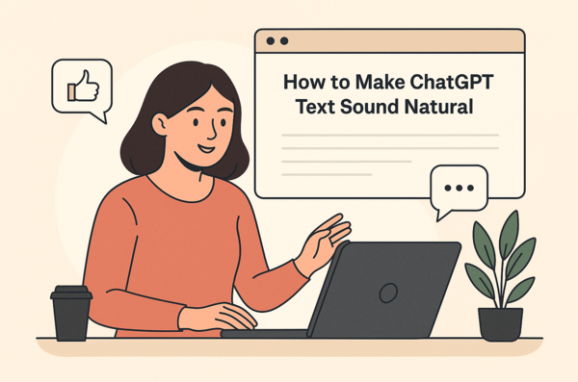Introduction: AI Can Write — But Can It Relate?
Okay, so here's the thing - yes, AI can write. But can it actually relate?
These days, AI isn’t just hanging out in tech labs. It’s become this mainstream productivity tool. Everyone’s using it to whip up blog posts, newsletters, product blurbs, video scripts. You name it.
But here’s a thought that hit me yesterday while rereading something ChatGPT wrote:
Do we actually need more content? Or better content?
Not just technically correct stuff. I mean content that feels like someone is talking to you. Something that connects. You know... like people do.
This is the path now - generating better, not just faster.
Let’s talk about what’s next. The future of AI content isn’t about bots doing more. It’s about humanization - making stuff sound less like it came out of a toaster.
Where We Are Now: AI Is Fast, But Flat
AI speed? Impressive. It can churn out a 1,000-word blog post before your toast pops. But the vibe?
Stale.
The current AI writing feels:
- Like it’s missing a soul
- Overly clean - like a hotel lobby
- Packed with clichés
- Empty of trust or personality
And let’s be honest - we’re getting smarter. We can tell when a piece was written by a bot. Even if it’s good... something’s just off.
People don’t connect with content that doesn’t feel like it was written by a real person.
The Problem With Robotic AI Writing
Even the top-tier stuff - GPT-4, Claude 3... they still fumble.
Things they still can’t quite grasp:
- Emotion that feels like real emotion
- Friendly phrasing - like how your cousin talks
- Cultural inside jokes or sarcasm
- Consistent brand voice that actually sounds like you
- Sentence rhythm that sounds... alive
This is usually the moment I sigh and grab a coffee.
Because this is when rewriting becomes more important than writing. You need to go in and reshape that flat, too-smooth content into something with bumps and freckles and awkward pauses. Real stuff.
The Shift Toward “Relatable AI Content”
So, here’s what’s happening now.
We’re shifting from:
> “Can AI write this?”
To:
> “Does this sound like someone who gets me?”
That’s the real question now. The Shift Toward “Relatable AI Content.”
And that’s what AI content humanization is all about. Making that auto-generated stuff sound more like a person, and less like a machine swallowed a copywriting handbook.
I tried this the other day with a tool called TrueWrite. Took a boring AI paragraph about customer service and made it feel like someone actually cared. Wild.
Humanized AI Content ≠ Edited AI Content
Let’s clear up a big confusion:
Editing is not the same as humanizing.
- Editing fixes grammar, passive voice, and structure. 📏
- Humanizing adds soul. Adjusts tone. Brings in feeling. Sprinkles in some randomness - the good kind.
It’s the difference between:
- A GPS giving you directions
- Your buddy describing how to get to that taco place (“Okay, so after the weird blue mailbox, take a left...”)
Who do you trust more?
Why Relatable Content Wins
Whether you’re a startup founder, a teacher, a product marketer, or someone writing LinkedIn thought pieces at 3AM...
Relatable content performs better.
Because when it feels human:
- People remember it
- People feel something
- People react - like, comment, share
- People buy
It’s not about tricking people. It’s about being real. Or at least feeling real in a sea of robotic sameness.
The Role of TrueWrite in the Future of AI Content
Here’s where TrueWrite comes in.
Not a grammar tool. Not a rephraser.
It’s built for:
- Taking clunky AI writing and rewriting it to actually connect
- Keeping your core message, but changing the vibe
- Switching tones - funny, straight, warm, whatever
- Working in 21 languages, which is... totally wild
- Helping your text pass AI detection tools (which, let’s be honest, are getting pretty good)
In a future where AI content is everywhere... TrueWrite makes yours different.
Explore how TrueWrite bypasses detectors
Future-Proof Your Content Strategy
Want to keep up?
Here’s what content folks need to do now:
- Use AI for rough drafts - it’s quick
- Use humanization tools like TrueWrite to rewrite for tone, emotion, you-ness
- Layer in your own voice, opinions, weird analogies, and backstories
- Focus on making people feel - not just stuffing their heads with info
Speed + Soul. That’s the formula.
Final Thoughts: AI Isn’t Going Away - But Neither Is Emotion
AI’s not disappearing. Neither is your brain. Or your heart.
The best stuff? It’s gonna be a mix.
A little bot. A lot of you.
Use AI to scale. But humanize to connect. That’s what actually sticks.
Because honestly, I don't remember the last AI-generated sentence I felt. But that message from my sister yesterday? The one about missing home and burning the rice again?
Yeah. That one stayed with me.
And maybe - maybe - that’s what your content should do too.
Paste your content now and see the future of writing in action

